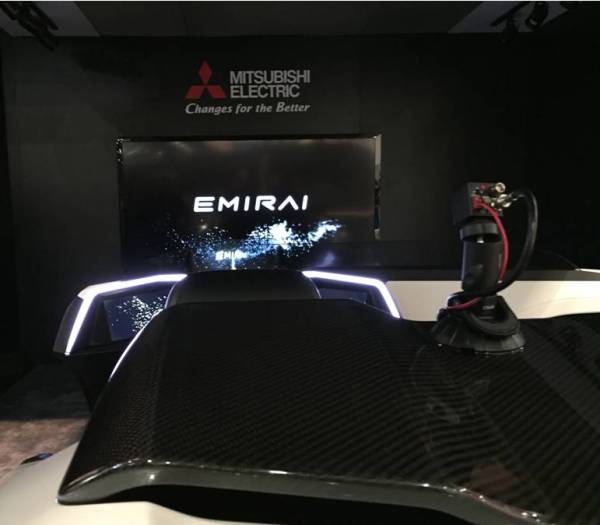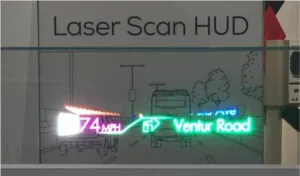With cars taking up a good portion of the CES exhibit space, the interest and availability of head up displays (HUD) was everywhere. While in the past years HUDs were a standalone technology to provide the driver with additional information, the position of a HUD in the automotive display world is changing.
Besides the integration of this display type into automotive MCUs, we are seeing an increasing number of car models being offered with a HUD option. The number of models has increased but also the technology has penetrated models at a lower price point. Since there are more cars sold at lower price points than expensive ones, the total number of HUD units installed in cars is increasing rapidly. In addition, with HUDs being a relative big deal and marketing topic for cars today, there is also a market developing for aftermarket devices.
The latest trend in HUDs is not so much the type of display technology used (even though laser was shown at several places) but the integration into the driver’s interaction with the car. Up until now it seemed that more and more information being put on the HUD was a description of the latest version, but this seems be changing for the better. In several places I heard that the amount of information has to be kept to a minimum for better acceptance of the device and driver safety. It is not clear if this comes from the HUD developers based on research studies, feedback from car manufacturers or just common sense. Nevertheless, HUDs are also suggested for other parts of the vehicle like the passenger seat where entertainment may play a much larger role.
Beside the difficulties photographing HUDs in general (camera autofocus and the virtual image do often play a trick on the image that you only see at home), some HUDs are repetitively dim, while others are very bright. It shows that brightness control under all kind of ambient light conditions are key to installing a HUD that the user will like.
Pioneer demonstrated their Laser based HUD system that was also integrated into their AADT (Advanced Automotive Technology Development) vehicle. Here the system uses a range of sensors to evaluate the driving situation and communicate with the driver. If your heart rate shows a drop in attention it will start talking to you and change the settings of the climate control to wake you up. There is also a lane observation technology included that combines with the navigation system and adds information about traffic and weather for example. All this while, the passenger can watch a movie on his wide format HUD. Keep in mind that we won’t see any of this technology any time soon.
Mitsubishi Electric showed a similar solution with a HUD installed in front of both the driver as well as the passenger seat. Again they hinted at the next generation of HUDs with their demonstration that integrates several aspects of driver support into one system. This included lane guidance and and a separate passenger infotainment system.

JVC Kenwood showed a similar approach by modifying a real McLaren. Since JVC is sponsoring the Formula 1 team of McLaren, they must have gotten a very good deal on the sports car, I assume! (I wouldn’t make that assumption, having tried to do deals with MaLaren in the past! – Man. Ed.) The JVC approach actually takes away all classical instruments and replaces it with a HUD that adopts its information based on configurable settings and driving situations. It also includes a digital mirror solution that uses cameras to display the car’s surroundings. They also can take images while the car is parked and play them back as a time-condensed video in case anything happened to the car while the driver was absent. I think a real good thing for a McLaren or other high end vehicles. For JVC, this field is a very important application as they make about 50% of their revenue in the automotive sector.
In a more detailed discussion with the development engineer, it became clear that this model is just the start of their work. While nothing of this technology is nearly close to being employed in real cars today, they are working on this kind of technology for the next generation of the technology or even the one after that. For example, in their installation the whole windshield is coated on the inside for the potential use of a HUD. With the right projection technology they could put information anywhere on the windshield, very much like science fiction movies suggest.

They see the current HUD models as generation 1 and their next model as generation 2. An AR HUD with lane observation and geo-mapping for information and navigation purposes is more likely to be found in generation 3 or 4 in their opinion.
The car makers themselves did not focus on the HUD as technology in any way, for them this is just an option in the order list that can be installed or not depending on the customer’s preference. Any more push of the technology is not need at this time.
Audi for example was one of the early adopters and took every opportunity to demonstrate this technology. This year they showed three cars, two of which had a HUD installed. Interestingly, of the three cars, the R8 V10 (their high end sports car) did not come with an HUD, while the A4 and the Q7 both had it installed.
Other car manufacturers that we talked to showed a very similar approach with their HUD integration. The HUD is a component of the car similar to a navigation system and the like. While it is being important for them to point out what new models can have the HUD option installed, it does not offer any more differentiator over competitors per se. It seems that now the HUD has to demonstrate not only a potential safety advantage but also increasing interest from customers. – NH

